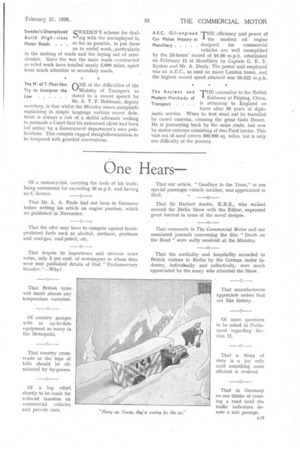Passing Comments
Page 32

Page 33

If you've noticed an error in this article please click here to report it so we can fix it.
The Kingston By-pass A T a meeting of the as a Most Disastrous rA Auctioneers and Estate
Example Agents Institute, Mr. J. A. Rosevear referred to the Kingston By-pass as a disastrous instance of the need for alteration in the methods by which new main roads were laid out. It was constructed at great cost through open country, but immediately became the Mecca of land speculators and builders of small houses. It now serves a chain of new communities, and slow traffic debouches at right angles from the service roads. For by-pass traffic, most of its value has been nullified, on several occasions it has been subject to such severe flooding as to render it almost impassable, and its record for accidents is distinctly bad.
1318
ELSEWHERE in this issue we refer to the Straussler 15-tonner which was demonstrated at Farnborough last week. Our remarks regarding the excellence of the suspension system are supported by an incident related to us by the driver of the machine, who, one day. dropped at Birmingham a small key. This slipped between the engine cowling and the floorboards, and was found some days later resting on one of the front transverse springs. The spring is but a few inches wide, and in the intervening period the machine had travelled several hundred miles. We would not advise tests of this nature with anything of value, but they certainly indicate a remarkable absence of vibration. Incident Demonstrating Excellence of Straussler Suspension
Sweden's Unemployed QWEDEN'S scheme for deal Build Highclass ing the unemployed is, Motor Roads . . . so far-as possible, to put them on to useful work, particularly in the making of roads and the laying out of aerodromes. Since the war the main roads constructed as relief work have totalled nearly 3,000 miles, apart from much attention to secondary roads.
The M. of T. Must Not nNE of the difficulties of the Try to Interpret the '1/4-/Ministry of Transport, as
Law . . . . . stated in a recent speech by Mr. A. T. V. Robinson, deputy secretary, is that whilst the Ministry issues pamphlets explaining in simple language various recent Acts, there is always a risk of a skilful advocate seeking to persuade a Court that his unlearned client had been led astray by a Government department's own publications. This compels rugged straightforwardness to be tempered with guarded reservations. A.E.C. 0 i 1-e ng in ed THE efficiency and power of Car Makes History at I the modern oil engine Montlhery designed for commercial vehicles are well exemplified by the 24-hours' record of 94.09 m.p.h. established on February 15 at Montlhery by Captain G. E. T. Eyston and Mr. A. Denly. The power unit employed was an A.E.C., as used on many London buses, and the highest record speed attained was 98.823 m.p.h.
The Ancient and
Modern Methods of THE counsellor to the British
Embassy at Peiping, China, is returning to England on Transport . . leave after 30 years of diplo matic service. When he first Went out he travelled by camel caravan, crossing the great Gobi Desert. He is journeying back by the same route, but now by motor caravan consisting of two Ford lorries. This vast sea of sand covers 300,000 sq. miles, but is only one difficulty of the journey.




























































































